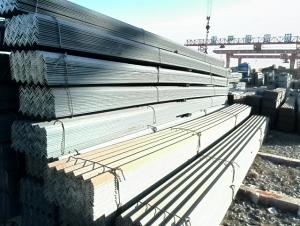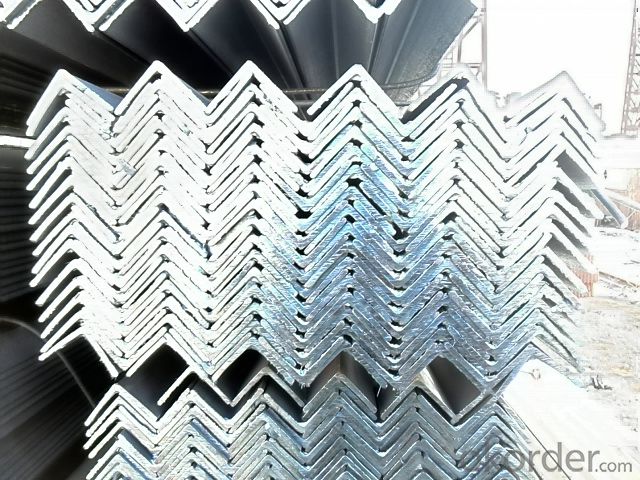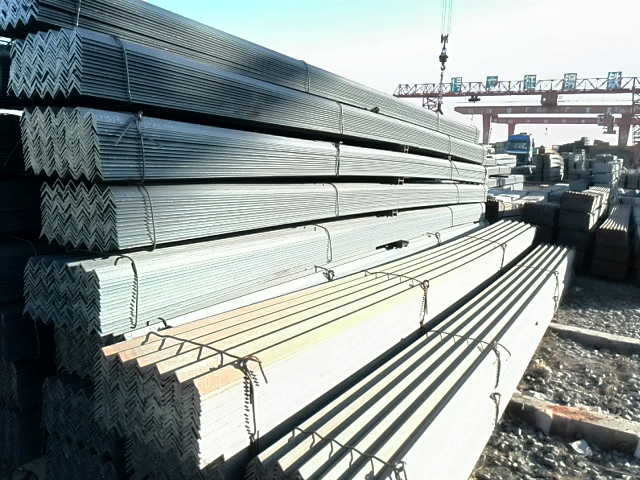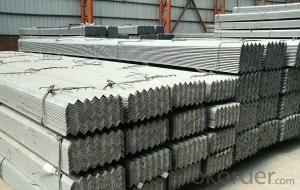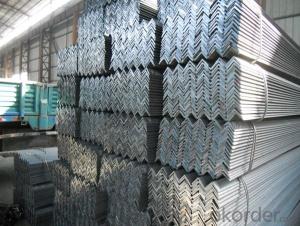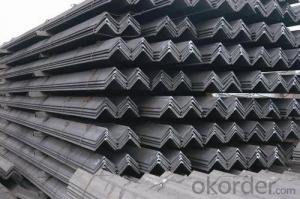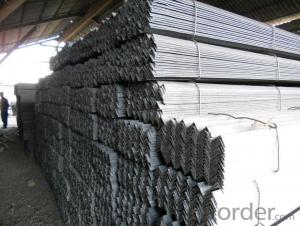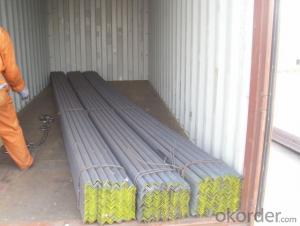Equal Angles Steel with Grade GB-Q235 for Structures
- Loading Port:
- Tianjin
- Payment Terms:
- TT or LC
- Min Order Qty:
- 25 m.t.
- Supply Capability:
- 10000 m.t./month
OKorder Service Pledge
OKorder Financial Service
You Might Also Like
Product Description:
OKorder is offering high quality Hot Rolled Equal Angle Steel at great prices with worldwide shipping. Our supplier is a world-class manufacturer of steel, with our products utilized the world over. OKorder annually supplies products to European, North American and Asian markets. We provide quotations within 24 hours of receiving an inquiry and guarantee competitive prices.
Product Applications:
Hot Rolled Equal Angle Steels are ideal for structural applications and are widely used in the construction of buildings and bridges, and the manufacturing, petrochemical, and transportation industries.
Product Advantages:
OKorder's Hot Rolled Equal Angle Steels are durable, strong, and resist corrosion.
Main Product Features:
· Premium quality
· Prompt delivery & seaworthy packing (30 days after receiving deposit)
· Corrosion resistance
· Can be recycled and reused
· Mill test certification
· Professional Service
· Competitive pricing
Product Specifications:
Manufacture: Hot rolled
Grade: Q195 – 235
Certificates: ISO, SGS, BV, CIQ
Length: 6m – 12m, as per customer request
Packaging: Export packing, nude packing, bundled
EQUAL ANGLES SIZES |
| ||
a(mm) | a1(mm) | thickness(mm) | length |
25 | 25 | 2.5---3.0 | 6M/12M |
30 | 30 | 2.5---4.0 | 6M/12M |
38 | 38 | 2.5 | 6M/12M |
38 | 38 | 3.0---5.0 | 6M/12M |
40 | 40 | 3.0---6.0 | 6M/12M |
50 | 50 | 3 | 6M/12M |
50 | 50 | 3.7---6.0 | 6M/9M/12M |
60 | 60 | 5.0---6.0 | 6M/9M/12M |
63 | 63 | 6.0---8.0 | 6M/9M/12M |
65 | 65 | 5.0---8.0 | 6M/9M/12M |
70 | 70 | 6.0---7.0 | 6M/9M/12M |
75 | 75 | 5.0---10.0 | 6M/9M/12M |
80 | 80 | 6.0---10.0 | 6M/9M/12M |
90 | 90 | 6.0---10.0 | 6M/9M/12M |
100 | 100 | 6.0---12.0 | 6M/9M/12M |
120 | 120 | 8.0-12.0 | 6M/9M/12M |
125 | 125 | 8.0---12.0 | 6M/9M/12M |
130 | 130 | 9.0-12.0 | 6M/9M/12M |
140 | 140 | 10.0-16.0 | 6M/9M/12M |
150 | 150 | 10---15 | 6M/9M/12M |
160 | 160 | 10---16 | 6M/9M/12M |
180 | 180 | 12---18 | 6M/9M/12M |
200 | 200 | 14---20 | 6M/9M/12M |
FAQ:
Q1: Why buy Materials & Equipment from OKorder.com?
A1: All products offered byOKorder.com are carefully selected from China's most reliable manufacturing enterprises. Through its ISO certifications, OKorder.com adheres to the highest standards and a commitment to supply chain safety and customer satisfaction.
Q2: What makes stainless steel stainless?
A2: Stainless steel must contain at least 10.5 % chromium. It is this element that reacts with the oxygen in the air to form a complex chrome-oxide surface layer that is invisible but strong enough to prevent further oxygen from "staining" (rusting) the surface. Higher levels of chromium and the addition of other alloying elements such as nickel and molybdenum enhance this surface layer and improve the corrosion resistance of the stainless material.
Q3: Can stainless steel rust?
A3: Stainless does not "rust" as you think of regular steel rusting with a red oxide on the surface that flakes off. If you see red rust it is probably due to some iron particles that have contaminated the surface of the stainless steel and it is these iron particles that are rusting. Look at the source of the rusting and see if you can remove it from the surface.
Images:
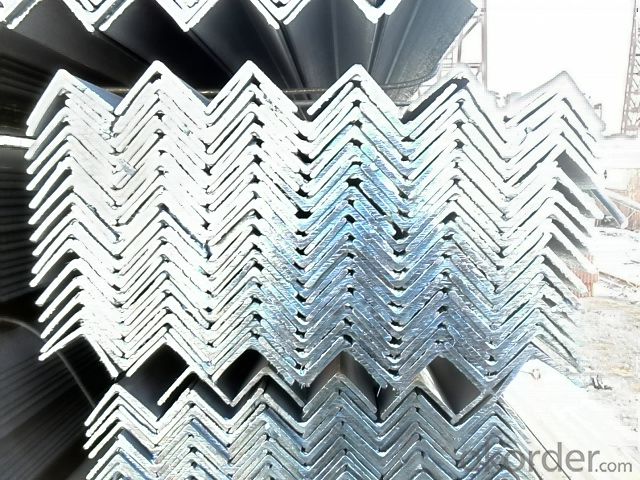
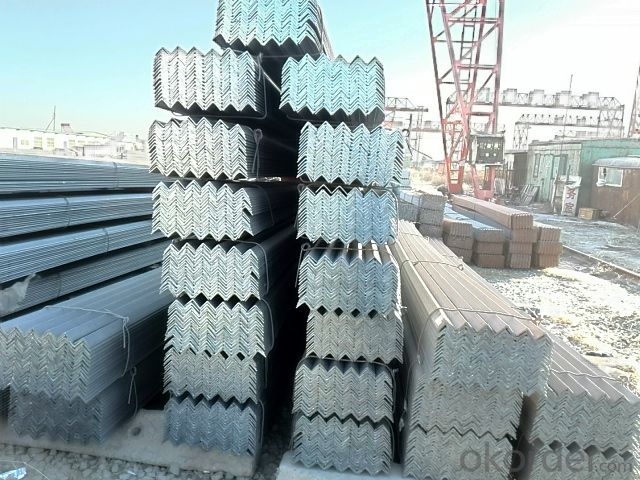
- Q: How do steel angles perform in terms of electrical conductivity?
- Steel angles have low electrical conductivity due to the high resistance of steel to the flow of electric current.
- Q: Can steel angles be used in HVAC ductwork installations?
- Indeed, steel angles have the capability to be utilized in HVAC ductwork installations. In the realm of ductwork systems, steel angles are frequently employed to furnish the necessary support and stability. Their typical function involves acting as brackets or supports, securing the ducts firmly in position and preventing undesirable sagging or collapsing caused by the weight of the air conditioning or heating equipment. Given their robustness and durability, steel angles are well suited to withstand the forces and vibrations inherent in HVAC systems. Moreover, the ease with which steel angles can be welded or bolted together allows for a secure and stable installation. To summarize, steel angles are an exceedingly reliable and widely utilized element in HVAC ductwork installations.
- Q: What is the maximum length for a steel angle?
- The maximum length of a steel angle can differ based on the angle's specific type and size, as well as the steel supplier's manufacturing capabilities. Typically, steel angles are offered in standard lengths spanning from 20 to 40 feet. However, longer lengths could be attainable via custom orders or specialized production methods. To ascertain the readily available or obtainable maximum length for a particular steel angle, it is advisable to seek guidance from a steel supplier or manufacturer.
- Q: What is the difference between hot-rolled and cold-formed steel angles?
- Hot-rolled steel angles and cold-formed steel angles are both used in various construction and industrial applications, but they differ in their manufacturing processes and resulting characteristics. Hot-rolled steel angles are produced by heating a steel billet or slab above its recrystallization temperature and then passing it through a series of rollers to achieve the desired shape. This process allows for the formation of bends, curves, and other complex angles. Hot rolling also results in a rougher surface finish and a slightly rounded edge, which may be favorable in certain applications. Additionally, hot-rolled steel angles tend to have a wider range of sizes and thicknesses available. On the other hand, cold-formed steel angles are made by bending a flat strip of steel at room temperature using a series of dies and rolls. This process does not involve heating the steel, which maintains its existing physical properties. As a result, cold-formed steel angles have a smoother surface finish and sharper, more defined edges compared to hot-rolled angles. The cold-forming process also allows for tighter tolerances and more precise dimensions. In terms of mechanical properties, hot-rolled steel angles generally have higher tensile strength and yield strength compared to cold-formed angles. This is due to the heat treatment involved in hot rolling, which refines the grain structure and enhances the overall strength of the steel. Cold-formed steel angles, while usually less strong, are often preferred in applications where weight reduction is a priority, as they are generally lighter than their hot-rolled counterparts. In summary, the main differences between hot-rolled and cold-formed steel angles lie in their manufacturing processes, resulting surface finish, dimensional precision, and mechanical properties. The choice between the two depends on the specific requirements and constraints of the project at hand.
- Q: Can steel angles be welded?
- Yes, steel angles can be welded.
- Q: Are steel angles available in non-standard sizes or custom shapes?
- Yes, steel angles are available in non-standard sizes or custom shapes. While standard sizes of steel angles are commonly found in the market, there are manufacturers and suppliers who offer the flexibility to produce angles in non-standard sizes or custom shapes. This allows customers to meet their specific project requirements, whether it be for structural, architectural, or other applications. Custom shapes can include unequal leg lengths, curved angles, or angles with specific hole patterns. These non-standard sizes or custom shapes may require special manufacturing processes, additional lead time, and possibly higher costs compared to standard sizes. However, the availability of steel angles in non-standard sizes or custom shapes provides customers with the versatility to address unique design needs and achieve desired outcomes.
- Q: What are the design standards for steel angles?
- The design standards for steel angles are typically governed by industry codes and standards, such as the American Institute of Steel Construction (AISC) Manual of Steel Construction or the European standard EN 10056. These standards outline the requirements for the dimensions, mechanical properties, and design capacities of steel angles, ensuring their safe and efficient use in structural applications.
- Q: Can steel angles be used in industrial or heavy-duty applications?
- Yes, steel angles can definitely be used in industrial or heavy-duty applications. Steel angles are known for their strength, durability, and versatility, making them suitable for a wide range of applications in various industries. They provide structural support, reinforcement, and stability in heavy-duty machinery, equipment, and infrastructure projects. Steel angles are commonly used in construction, manufacturing, engineering, and transportation industries, among others. They can be employed in applications such as frames, supports, bracings, platforms, beams, and trusses, where strength and load-bearing capabilities are crucial. Additionally, steel angles can withstand high temperatures, extreme weather conditions, and heavy loads, making them suitable for challenging industrial environments. Overall, steel angles are a reliable and efficient choice for industrial or heavy-duty applications due to their strength, durability, and adaptability.
- Q: Are steel angles corrosion resistant?
- Steel angles are generally not corrosion resistant unless they are specifically designed and treated to be so. Regular steel angles are made from carbon steel, which is susceptible to corrosion when exposed to moisture, oxygen, and other corrosive elements. However, there are stainless steel angles available that have a higher resistance to corrosion due to the addition of chromium and other alloying elements. These stainless steel angles are commonly used in environments where corrosion is a concern, such as marine or industrial applications. It is important to consider the specific type and grade of steel angle being used to determine its corrosion resistance capabilities.
- Q: How do you determine the appropriate length of a steel angle for a specific application?
- Determining the appropriate length of a steel angle for a specific application involves considering several factors. Firstly, you need to assess the structural requirements of the application. This includes analyzing the loads and forces that the steel angle will be subjected to. You should determine the maximum load capacity the steel angle needs to support and ensure that its length can adequately distribute the load without excessive deflection or failure. Secondly, you should consider the dimensions and layout of the application. Measure the available space and determine how the steel angle will fit within the overall structure. Consider any constraints such as adjacent components or obstructions that might affect the length of the steel angle. Next, you should consult relevant engineering and construction standards. Codes and guidelines provide recommended design values and specifications for steel angles based on their intended use. These standards can help you determine the appropriate length based on the application requirements and the material properties of the steel angle. Additionally, it is important to consider the fabrication and installation process. Evaluate the manufacturing capabilities and limitations, as well as any specific requirements for joining or fastening the steel angle. This will help determine if the desired length is feasible and practical in terms of fabrication and installation methods. Finally, it is advisable to consult with a structural engineer or a qualified professional in the field. They can provide expert advice and calculations based on the specific application, ensuring that the chosen length of the steel angle meets all necessary safety and performance requirements. In conclusion, determining the appropriate length of a steel angle for a specific application involves analyzing the structural requirements, considering the dimensions and layout, referring to relevant standards, evaluating fabrication and installation processes, and seeking professional guidance when needed.
Send your message to us
Equal Angles Steel with Grade GB-Q235 for Structures
- Loading Port:
- Tianjin
- Payment Terms:
- TT or LC
- Min Order Qty:
- 25 m.t.
- Supply Capability:
- 10000 m.t./month
OKorder Service Pledge
OKorder Financial Service
Similar products
Hot products
Hot Searches
Related keywords


